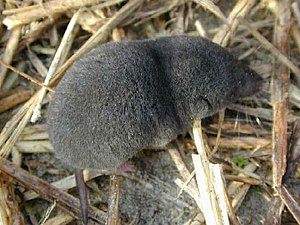American short-tailed shrews
| American short-tailed shrews | ||||||||||||
|---|---|---|---|---|---|---|---|---|---|---|---|---|

Southern short-tailed shrew |
||||||||||||
| Systematics | ||||||||||||
|
||||||||||||
| Scientific name | ||||||||||||
| Blarina | ||||||||||||
| Gray , 1838 |
The American short-tailed shrews ( Blarina ) are a genus of shrews found in southern Canada and the USA with four species:
- The northern short-tailed shrew ( B. brevicauda ) is the largest species. Its range extends from Saskatchewan and Nova Scotia to Nebraska and Georgia .
- The southern short-tailed shrew ( B. carolinensis ) is the smallest species and lives in the southeastern United States (from Virginia to Florida ).
- The Elliot short-tailed shrew ( B. hylophaga ) resembles the southern short -tailed shrew , except for details in its skull and teeth structure. She lives in the southern United States (from Nebraska and Iowa to Texas ).
- The Everglades short-tailed shrew ( B. peninsulae ) lives in Florida.
description
American short-tailed shrews have a silky, gray-colored fur, with the underside being barely noticeably lighter than the upper side. Their physique is robust, their ears are hidden in their fur. Their snouts are shorter and thicker than those of other species of shrew. These animals reach a head trunk length of eight to eleven centimeters and a weight of 15 to 30 grams. The genus owes its name to the short, only 1.5 to 3 centimeters long tail. American short-tailed shrews are among the few poisonous mammals : the salivary glands secrete the poisonous enzyme Blarina toxin , which is mainly used to catch prey.
Way of life
These animals inhabit various habitats, such as bushland, forests, swamps and marshes, but also live near humans such as in fields and gardens. In winter they sometimes retreat to barns or cellars. They are mainly nocturnal animals that build nests in burrows or under tree trunks or rocks. They build tunnels under leaves, rotten plant material or in the snow and sometimes also use burrows of voles or moles . Short-tailed shrews are territorial loners, they mark their territory with scent glands that secrete a secretion that smells of musk .
The predators of these animals include snakes , owls and birds of prey , weasels , foxes and coyotes . Short-tailed shrews try to evade them by hiding in the thick vegetation, and they also use the foul-smelling musk odor of their scent glands to scare off their enemies. They are only allowed to use their poisonous saliva to kill prey.
food
American short-tailed shrews eat a lot. It is estimated that they eat three times their weight every day, and their venom can overwhelm prey larger than themselves. They are not picky and eat both invertebrates ( insects , spiders , millipedes ) and vertebrates such as amphibians or mice as well as plants such as berries. These animals use echolocation (similar to whales or bats ). They emit sounds in the ultrasonic range and can use the echo to locate their prey.
Reproduction
The breeding season extends from March to September, the female can have up to three litters a year. After a gestation period of around three weeks, an average of five to seven (maximum up to ten) young animals are born. These are initially naked and blind and grow up in a nest. They leave this at around three weeks and are weaned shortly thereafter (around 25 days). Sexual maturity occurs at the age of six to twelve weeks. The life expectancy of these animals is a maximum of three years, but is usually shorter.
threat
On the one hand, short-tailed shrews are a nuisance, as they crawl into houses in winter and give off their foul smell there. In addition, their poisonous bite is feared, although it is not fatal but only causes painful swellings lasting several days. Reports of bites are rare, however. On the other hand, they consume large numbers of insects and small vertebrates. The greatest danger for them is likely to come from agriculture, which is destroying part of their habitat. However, all species are considered widespread and are not threatened.
literature
- Ronald M. Nowak: Walker's Mammals of the World. 2 volumes. 6th edition. Johns Hopkins University Press, Baltimore MD et al. 1999, ISBN 0-8018-5789-9 .
- Don E. Wilson , DeeAnn M. Reeder (Eds.): Mammal Species of the World. A taxonomic and geographic Reference. 2 volumes. 3. Edition. Johns Hopkins University Press, Baltimore MD 2005, ISBN 0-8018-8221-4 .
Web links
Individual evidence
- ↑ Deadly Poison: Evolution equips shrew and lizard with the same weapon. Spiegel-Online, October 30, 2009.